Mous Extreme Commuter Backpack with Lid Review
The Mous Extreme Commuter Backpack with Lid has a rigid structure that hones in on tech protection, though it has a noticeable effect on carrying comfort.
Our Verdict
Save time. Get access to brief summaries of our reviews so you can browse and make decisions more efficiently.
Pros
- Rigid structure makes packing easy
- The key leash pocket is fairly easy to access without having to swing the bag around
- AiroFoam lining beneath the laptop sleeve boosts device protection
Cons
- Back panel can be uncomfortable as it doesn’t contour to your back
- Top pocket’s fleece liner pops out consistently when grabbing gear
- Items packed in the main compartment block access to pockets along the back side
Technical Details
-
Capacity
25l
-
Weight (lb)
3.97 lb (1.8 kg)
-
Dimensions
18.9 in x 13 in x 6.69 in (48 x 33 x 17 cm)
-
Notable Materials
Nylon, Kodra Nylon, Polyurethane (PU), Spandex, Aluminum, EVA Foam, FIDLOCK Hardware, Hypalon®, Woojin Hardware, YKK Zippers, Meets bluesign® Criteria
-
Tablet Sleeve Size
12.9"
iPad Pro without a sleeve
-
Laptop Compartment Size
16"
MacBook Pro without a sleeve, or a 13” MacBook Pro in a Mous sleeve
-
Warranty Information
Full Review
The Mous Extreme Commuter Backpack with Lid has a pretty extensive feature list involving fancy names like AiroFoam, FIDLOCK, Hypalon, and PU coating. Whichever word you pick from their page, though, it’s in the name of one particular goal: tech protection. However, we’re here to test the entirety of this bag, not just how effectively it provides laptop protection, for example.
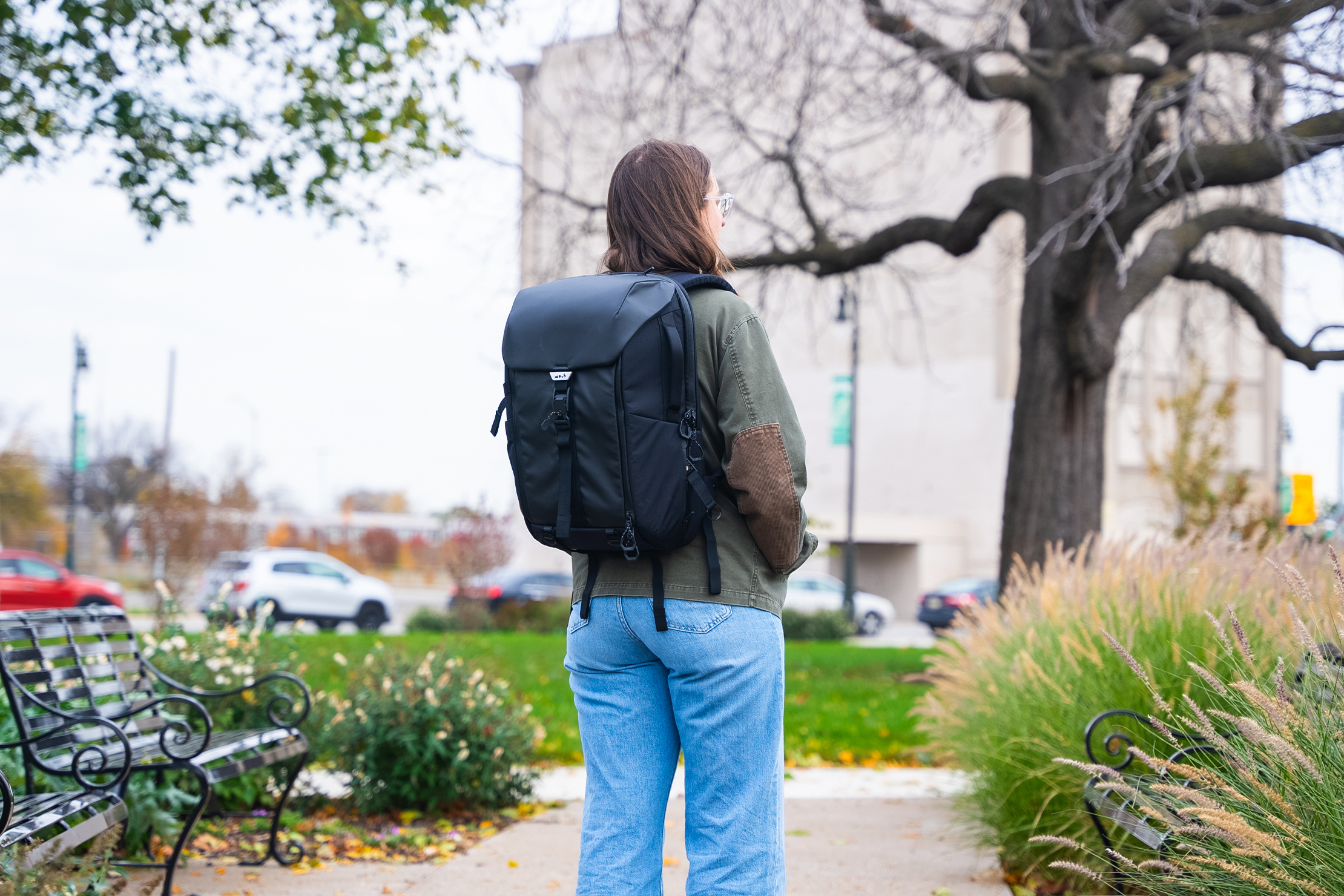
This focus on tech protection seems to have yielded a few interesting side effects in this backpack. For example, the rigid structure, courtesy of its materials and construction, also impacts how it carries (spoiler alert: it’s negative). Another example would be the fleece-lined top pocket, where the liner consistently pops out whenever we remove gear. All of this is to say that when features result in both pros and cons, it’s worth scrutinizing all of them—so let’s do just that!
External Components
The Extreme Commuter Backpack’s build quality feels solid; we have no qualms about that. The entire bag feels very structured, and Mous doubles down on it with the aesthetics. The bag is all black (the only colorway available at the time of writing) and features a blend of nylon texture and PU-coated sections. The matte appearance of the latter makes the bag look very sleek and modern.
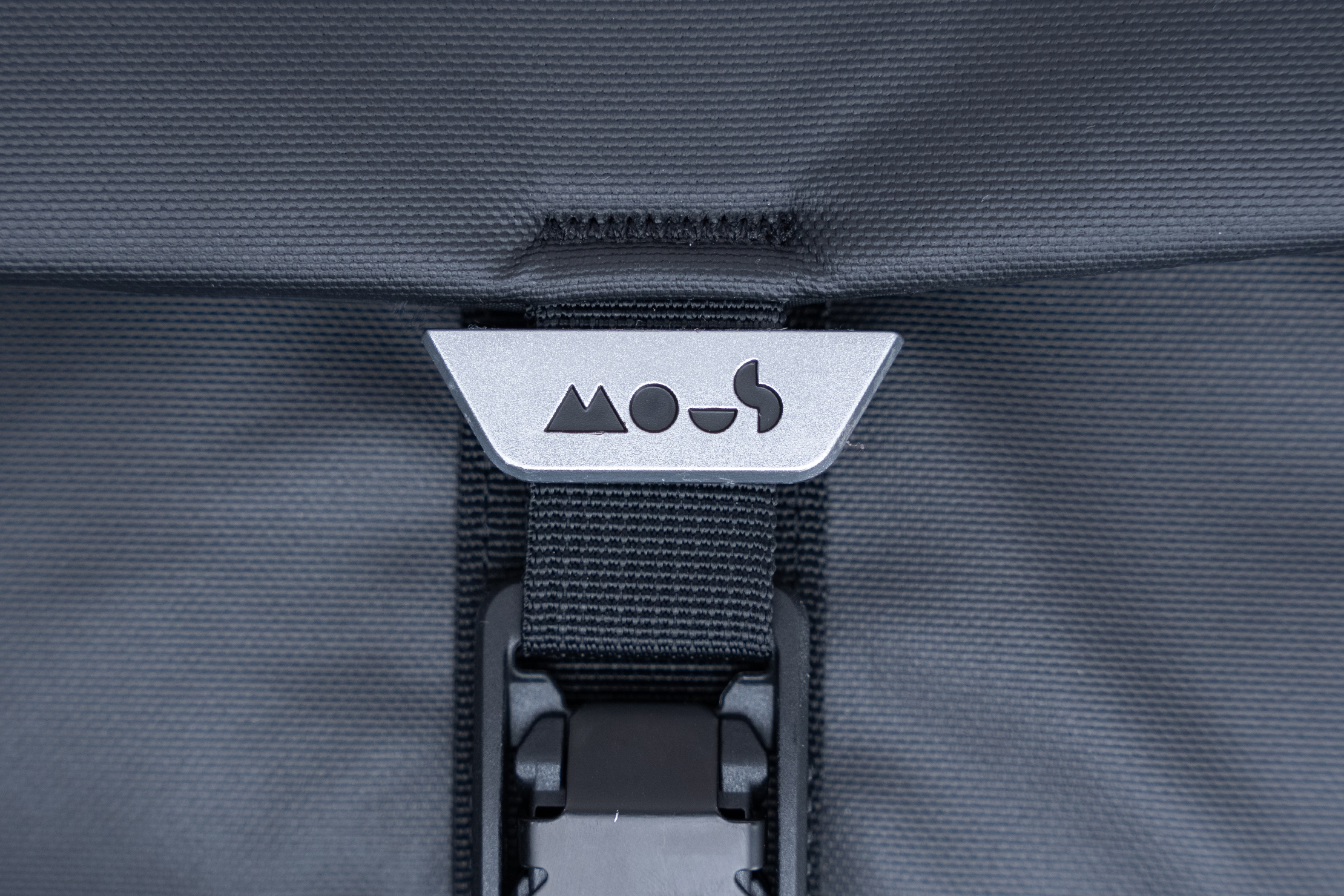
Of course, none of this styling and feel matter if they lack practicality. Fortunately, PU coating not only satisfies our weakness for matte finishes but is also an effective way to make fabrics very water-resistant. This should come as no surprise, given this bag’s high emphasis on tech protection. Another key indicator is the liberal use of AquaGuard-style YKK zippers. Whereas we typically see them on one or two thick zipper tracks on most bags, Mous put them on all of the Extreme Commuter Backpack’s external openings. Doing it this way has its own drawbacks, though.
The main one we’re most concerned about is ease of use. Thick zippers like these tend to have a ton of resistance, especially when the tracks go around sharp corners. Fortunately, most of the zippers here are fairly smooth to operate, even in the middle of a busy commute. We never had to fight the zippers to get to our own gear—a baseline expectation, if we’re being honest.
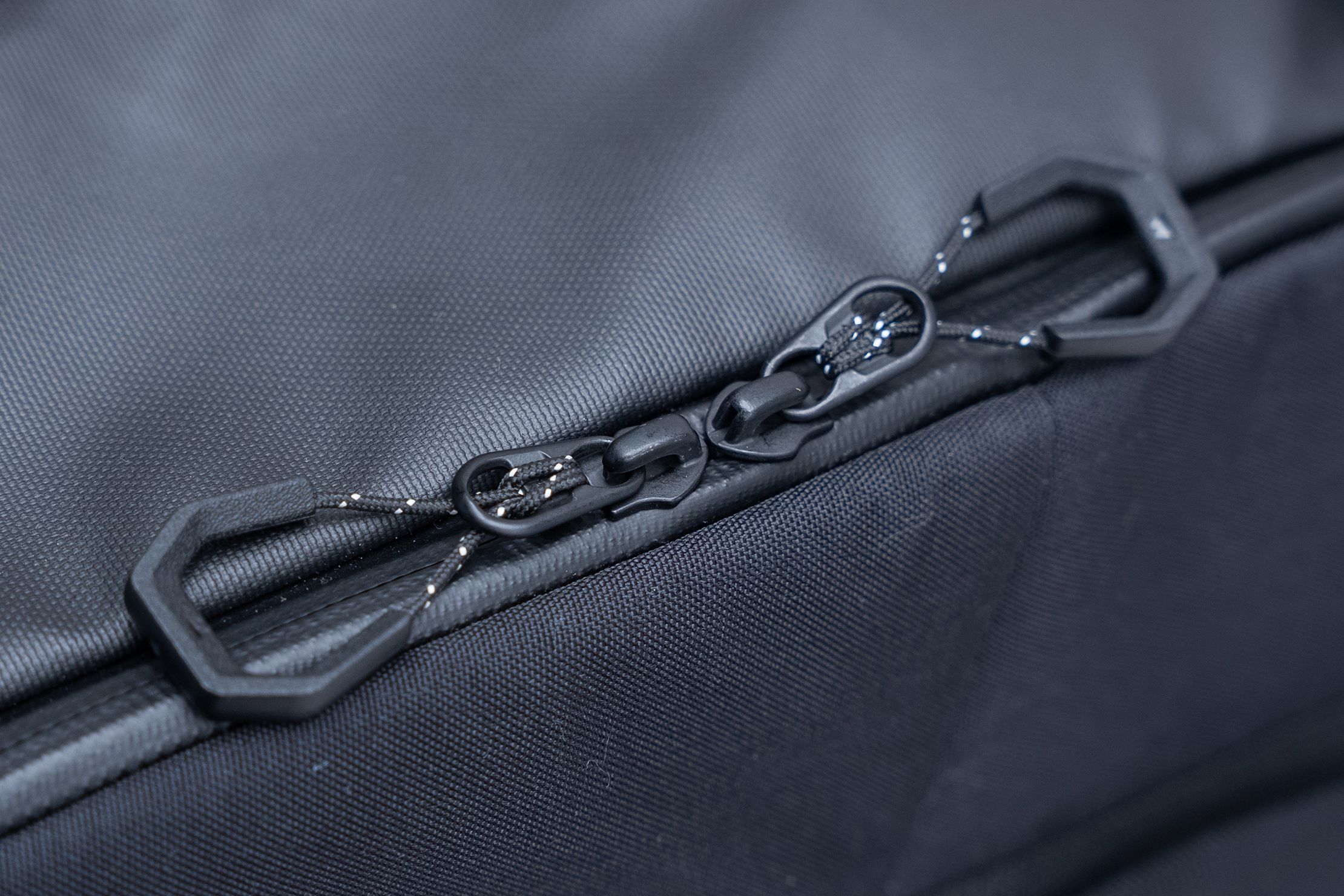
So far, the Extreme Commuter Backpack’s worst enemy seems to be pet hair. It sticks rather easily, though it’s also very easy to wipe off. Moreover, it mostly sticks to the non-PU-coated parts of the bag, most notably the base. Speaking of the base, there are a pair of accessory straps here, with G-hooks keeping them in place. You can use these to sling extra bulky gear externally, like smelly shoes or yoga mats, and we dig that they come with strap keepers so that the slack doesn’t dangle while we’re carrying the bag.
You’ll find the only water bottle pocket on the left side of this bag. It’s a simple fabric pocket with a piece of elastic providing the grip. As far as water bottle pockets go, it’s on the tighter side, providing a snug fit for an 18-ounce Hydro Flask insulated bottle. Anything bigger will struggle to squeeze inside, which is bad news if you already have wider bottles north of 20 ounces.
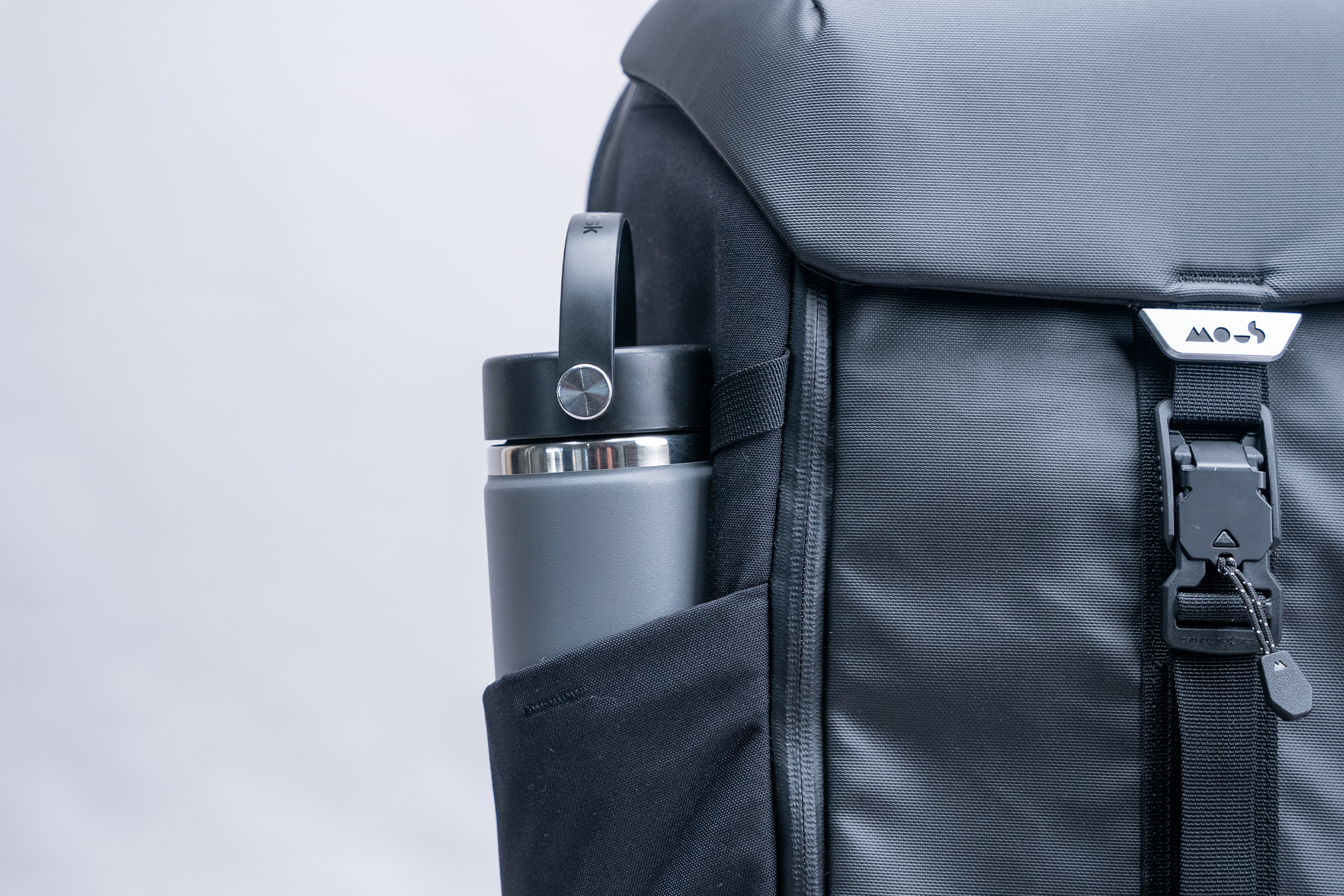
You can also slide other types of gear into this pocket, like a compact tripod or foldable umbrella. There’s even a G-hooked strap above the pocket to better secure this type of gear. We typically use it to anchor the handle of water bottles to stop them from randomly slipping out and rolling down the plane cabin (a situation that has happened to us with a different bag).
On the opposite side is the bag’s carry handle. The good news is it’s relatively well-padded for the bag’s size and weight. So much so that it’s our preferred way to lug the bag around whenever strapping in the harness system is too much work. On the other hand, its corner location makes for an unbalanced carrying feel. That said, it’s still a better option than the super thin handle between the shoulder straps, which is best to use just for hanging the bag behind restroom stalls.
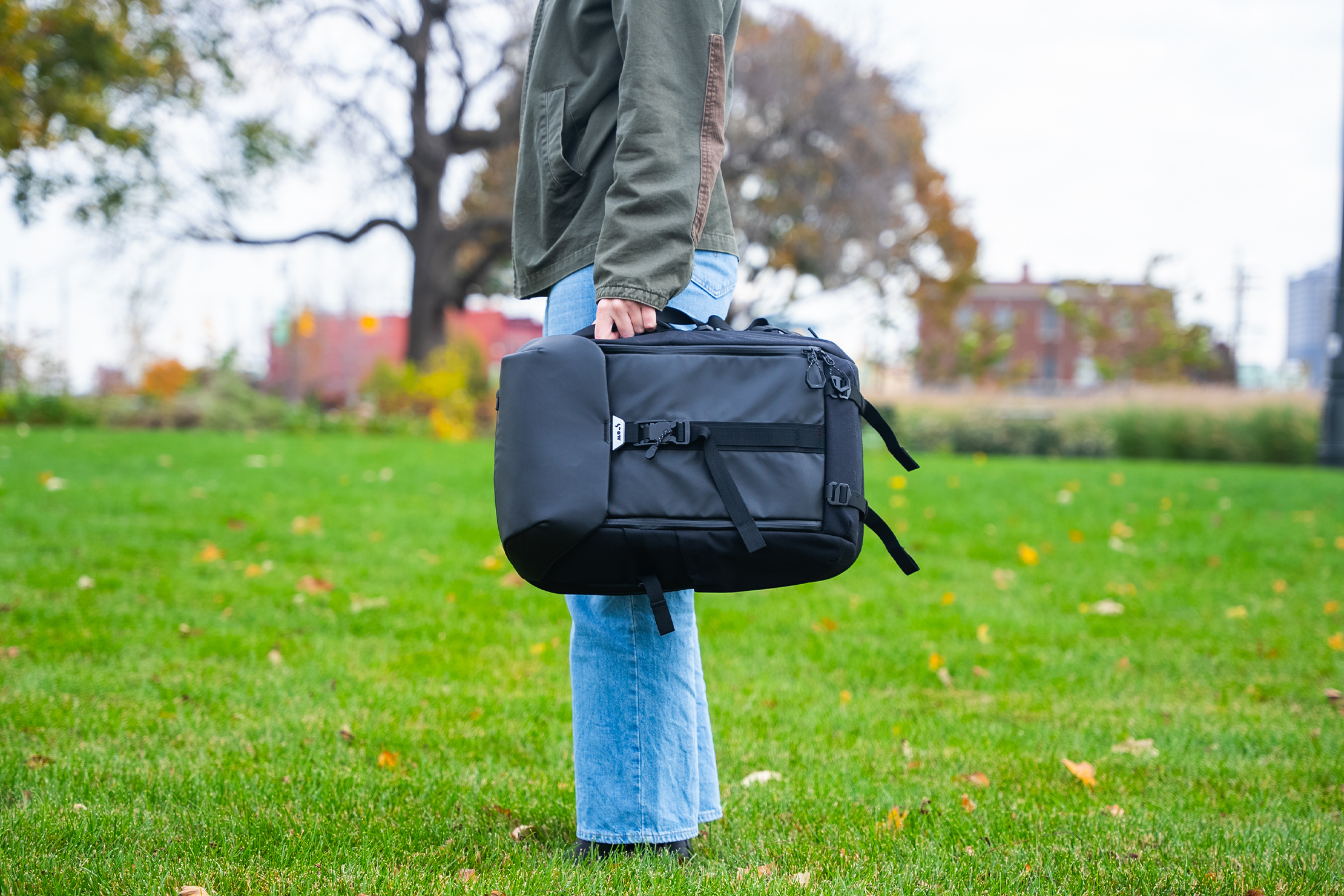
Technically, the wide loop at the front can also be used as a handle. However, it works best for sliding the bag along surfaces, like across your car trunk, to your travel companion sitting across you, or out from underneath your seat.
We’re not expecting anything too crazy with this bag’s harness system. At 25 liters and a commuter-focused design, load lifters and a hip belt, for example, feel overkill. Indeed, what we find are a pair of thick shoulder straps. This makes sense since the bag does pack a ton of padding, making it hefty despite its daypack-centric design.
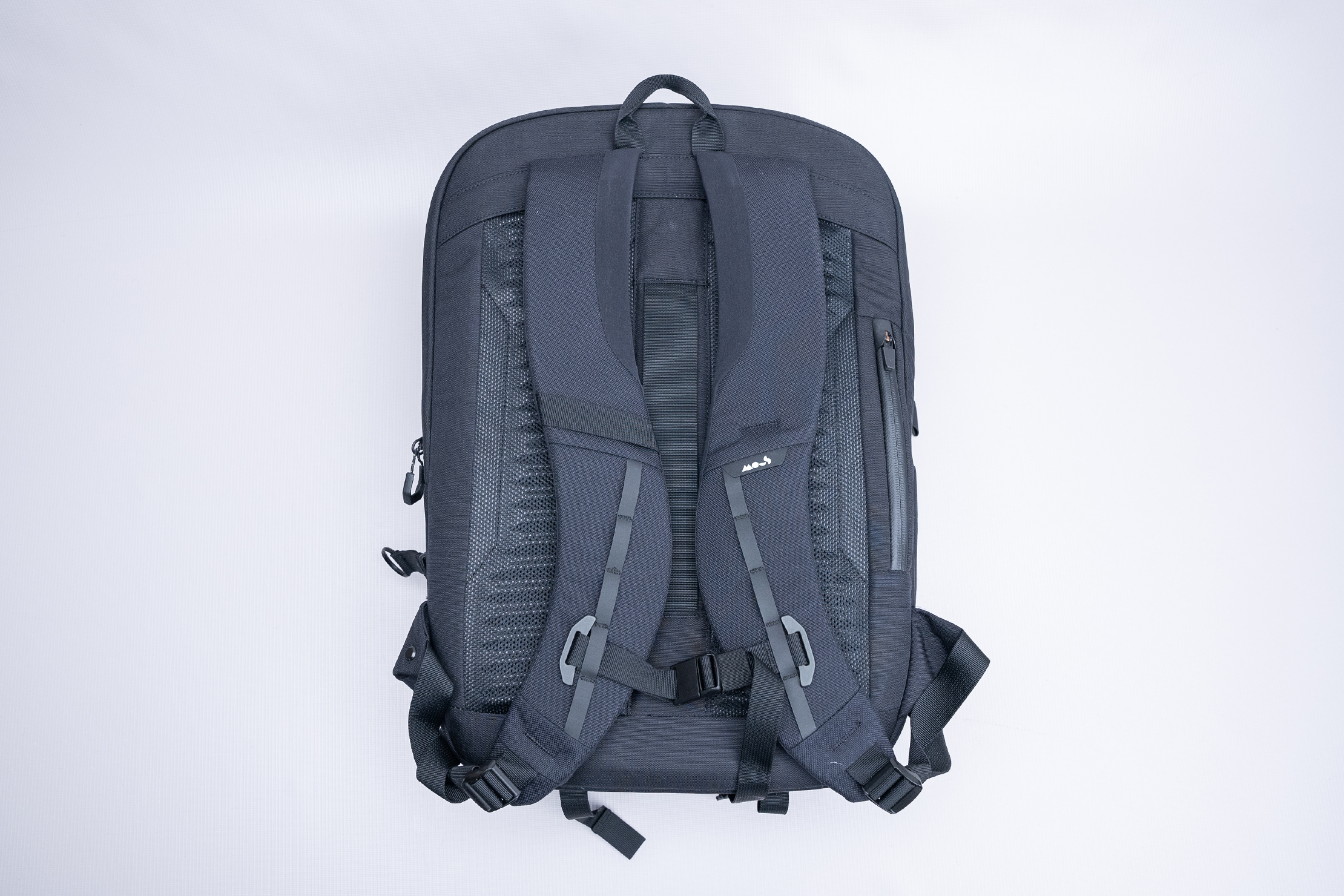
The top half of the straps are lined with softer, mesh-like fabric than on the bottom, presumably to counter the relative stiffness of the foam padding. The straps’ curved shape provides a more natural fit against the contours of your wearer’s body, which is nice to see given how wide they are—thick straps like these would feel suffocating if they were just straight.
There is also a loop on each side for attaching accessories like keychains. Unfortunately, the sternum strap also mounts via loops. To be fair, it usually works just fine, but once you’ve used a backpack with a rail-mounted sternum strap, you’ll find it’s just a much better experience. For one thing, those deliver a ton of granular adjustment. Plus, you don’t have to mess around with fiddly anchors and toggles like the one here.
Okay, we do like the Hypalon material used for the loops. The anchors also stay in place well enough that we don’t worry about the sternum strap going AWOL. All in all, just set the sternum strap to the best height that fits you, leave it at that, and hope you don’t have to readjust it midway through your trip.
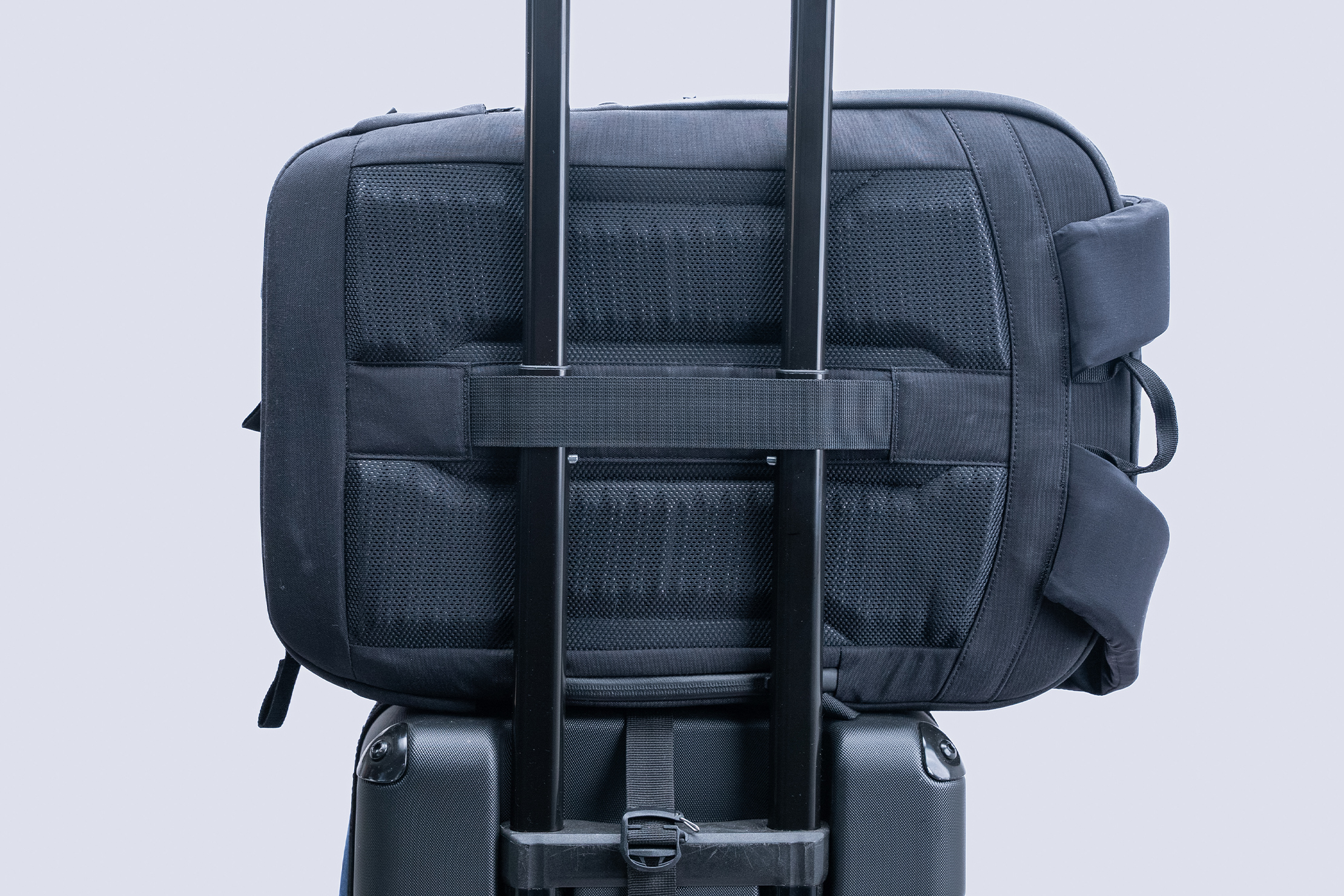
The back panel also features a lot of mesh-covered padding, which means air should have an easier time passing across your back. That said, we think the good breathability you’re getting here has more to do with the structuredness of the back panel rather than the mesh or texture. There’s also a luggage pass-through that could prove useful in case you ever want to pair this bag with roller luggage.
Fit Notes

The harness system itself does a good job of supporting the bag’s weight on the shoulders. The straps are a bit stiff, but not so much that it bothers us. Wearing the sternum strap isn’t entirely necessary, but it does pull a decent amount of weight forward, so you’ll want to try it out for yourself and not just discard it offhand.

If you want a more compelling reason to use the sternum strap, that would be the back panel’s rigidity. It doesn’t exactly contour to the curved shape of your back, leaving gaps where air can freely pass through (as we’ve mentioned earlier). Consequently, this bag really feels like it’s on you, as opposed to being worn by you, so you may want to pull its weight more forward using the sternum strap.
Inside The Backpack
Just below the side handle is a small zippered pocket for a few everyday carry items, like your keys and a minimalist wallet. This pocket (and the bag’s other secondary pockets) utilizes a self-locking zipper. If you fold the metal pull down, it won’t zip up or down. We really like the pocket’s location because it’s easy to reach without swinging the bag around in front of you. It’s doubly ideal because inside is a key leash with a detachable magnetic end so you can untether your keys when you need to use them. Just reach to your side, unzip, pull out your keys, and detach!
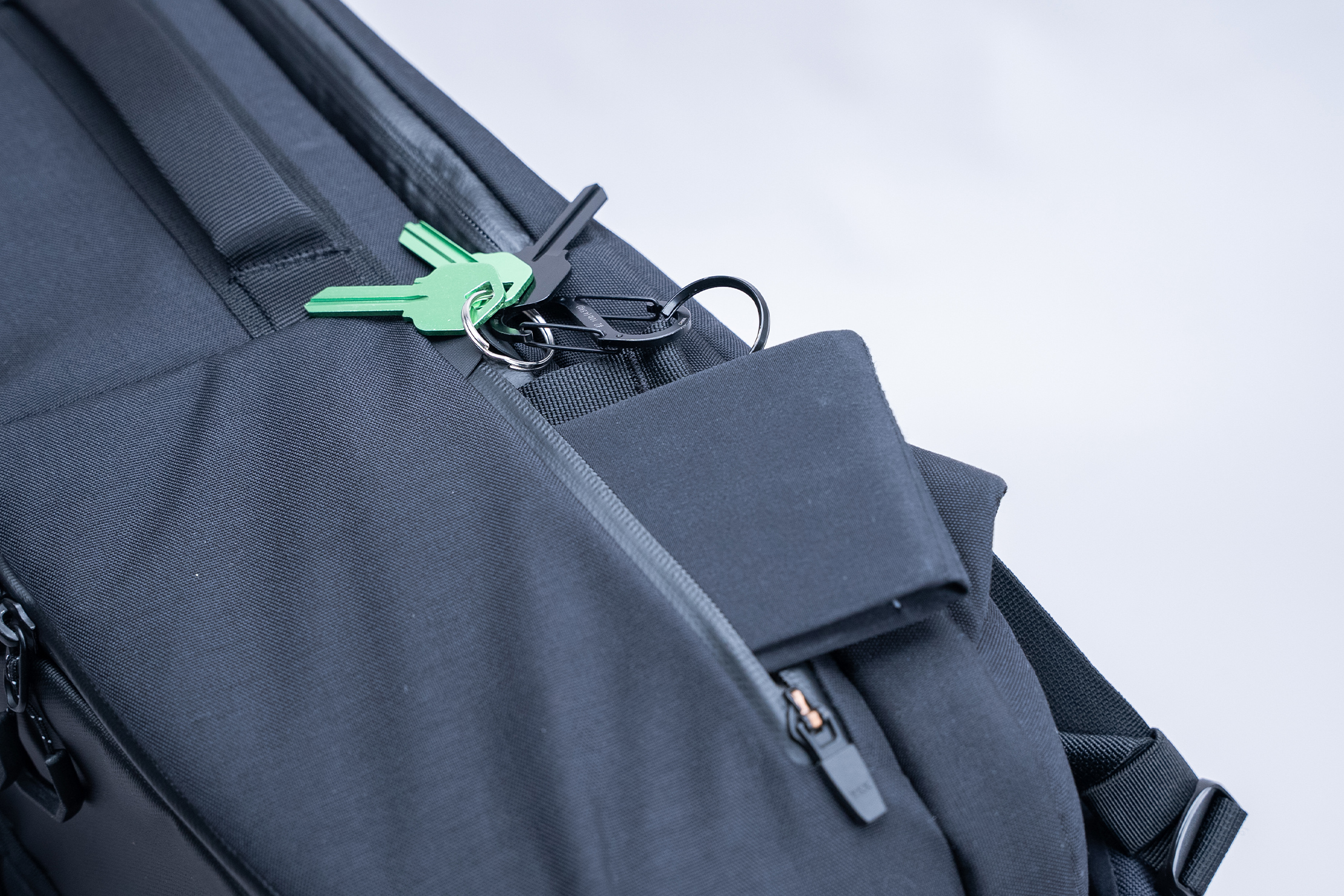
That pocket doesn’t have much space, so, fortunately, there’s still the top pocket for the rest of your everyday carry gear. The pocket covers a significant portion of the bag’s lid area, so there’s a good amount of space to use. However, the soft fleece lining tends to come out along with your gear. That’s a bit annoying for a pocket you use it frequently, though the fleece lining is good for keeping fragile gear scratch-free.
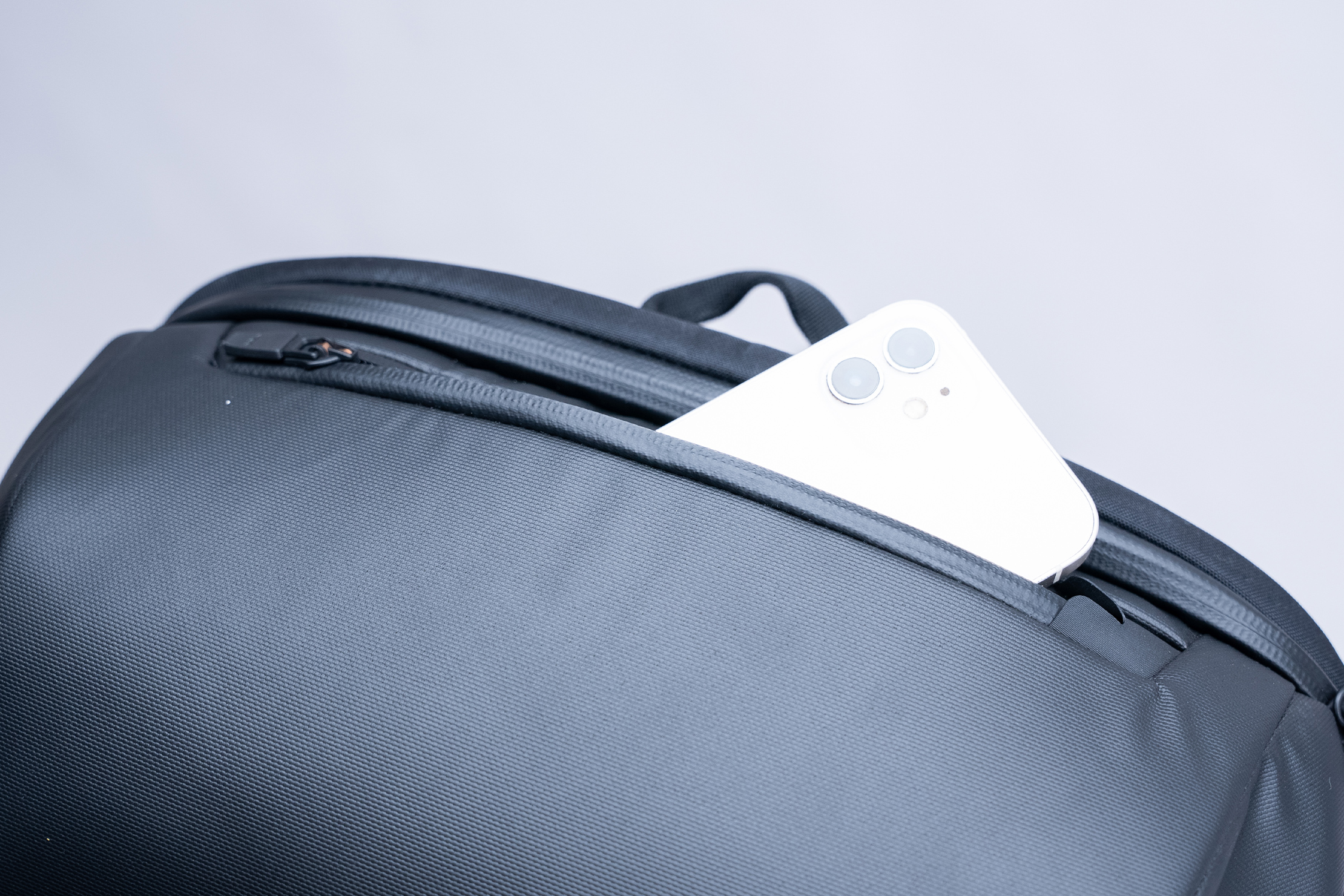
There’s a security pocket on the left-hand side of the bag, near the back panel. Like the first pocket we mentioned, this one is also quite tight on space. That’s okay, though, since it’s only meant for slim essentials like travel documents, spare cash, and embarrassing vacation photos (yes, those count).
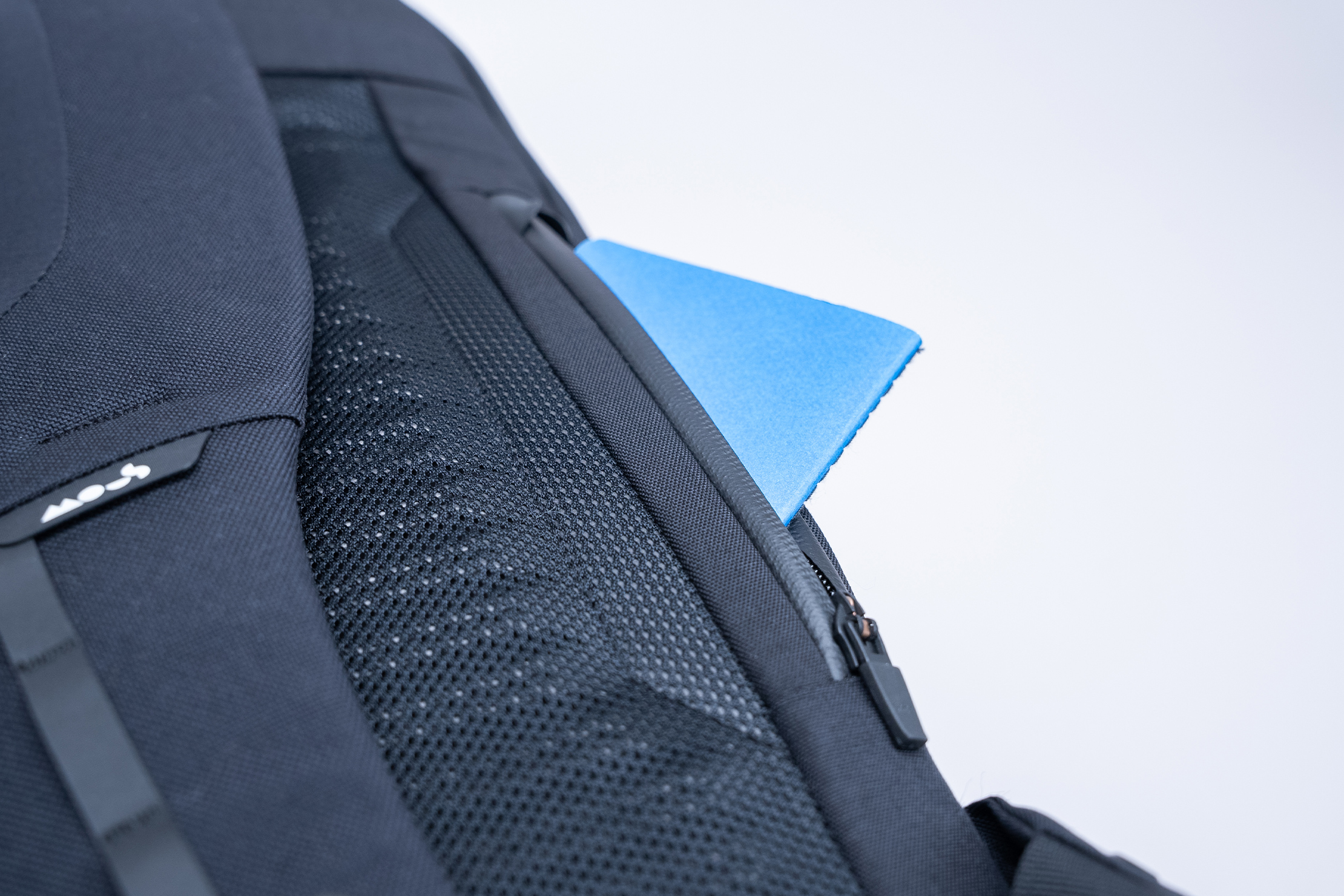
Arguably, the headlining feature of the Extreme Commuter Backpack is its laptop compartment. This is where a lot of the protective features are centered, starting with the lockable zippers. Inside and deep down the compartment is a large chunk of foam—called AiroFoam—resting beneath the laptop sleeve. Whereas other brands settle for just a false bottom, Mous doubles down with this extra bit of cushioning for better impact absorption. That said, we would’ve liked to see even more space between the bottom of the laptop sleeve and the actual base of the bag. As it stands, there’s only a relatively small gap where the foam can absorb impacts.
In terms of space, there’s a sleeve for up to a 16-inch MacBook Pro or a 13-inch MacBook Pro in a separate Mous laptop sleeve. An adjacent pocket can also hold a 12.9-inch iPad Pro, though we use this for a travel-sized keyboard, which fits just as well.
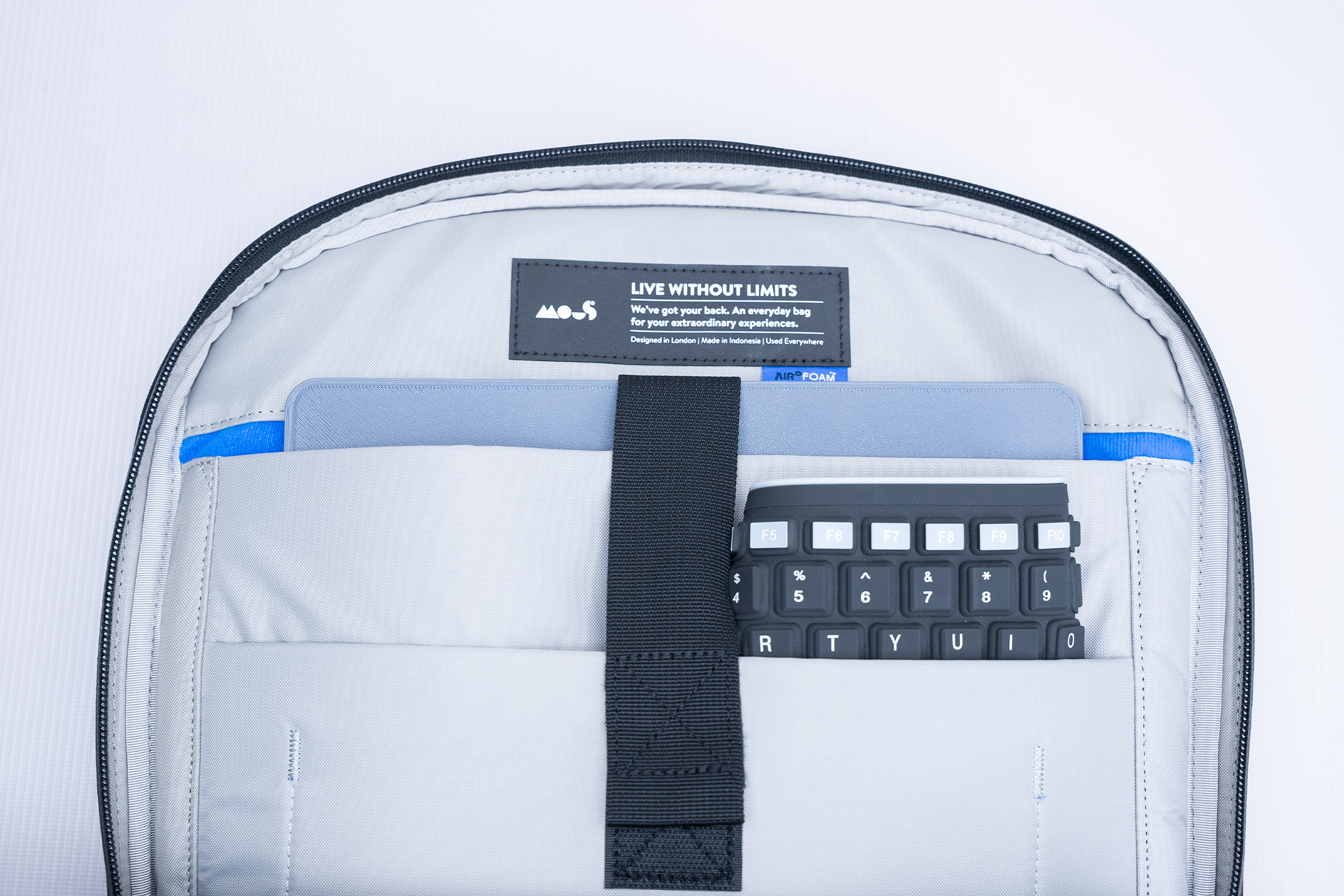
You have to go through the bag’s lid before getting into the main compartment. It’s secured via an adjustable FIDLOCK latch, making it easy to open and close. However, we found that overtightening the latch’s strap can make it hard to undo the FIDLOCK buckle. Some slack is required to unhook it, so just keep that in mind. It’s also worth noting that there’s a lidless variant that doesn’t have this tiny issue, but we won’t get into that in this review.
The main compartment fully opens via the two zippers that go around to let the entire front fold out (clamshell-style). This grants you a huge opening that really makes packing bulky items easy, especially since the bag’s structure means the sides don’t collapse as you do so. You can also get quick access by only undoing the top area, effectively turning this bag into a top-loader. It’s not the easiest way to access gear at the bottom, but you can at least get to the topmost zippered pocket and whatever is near that part.

There is a lot of organization inside the main compartment. On the lid side are three zippered pockets, each bigger as you go down. These are best to utilize first since the rest of the pockets at the back side aren’t easy to access once you load up the rest of your gear. Those rear pockets include a C-shaped pocket and a large zippered pocket. Use these for your least-frequently used items or used clothing you won’t take out until the end of your trip. This goes double for the C-shaped pocket because its zipper is very tricky to get around corners where it bumps up against the interior ceiling.
There’s also a liner pocket with a diagonal opening adjacent to the bottom zippered pocket. However, it’s a shame that it’s deep within an area we can’t reach most of the time. The same goes for the right-side pocket, which might be handy for storing a spare power bank if you want to be extra prepared for long trips.
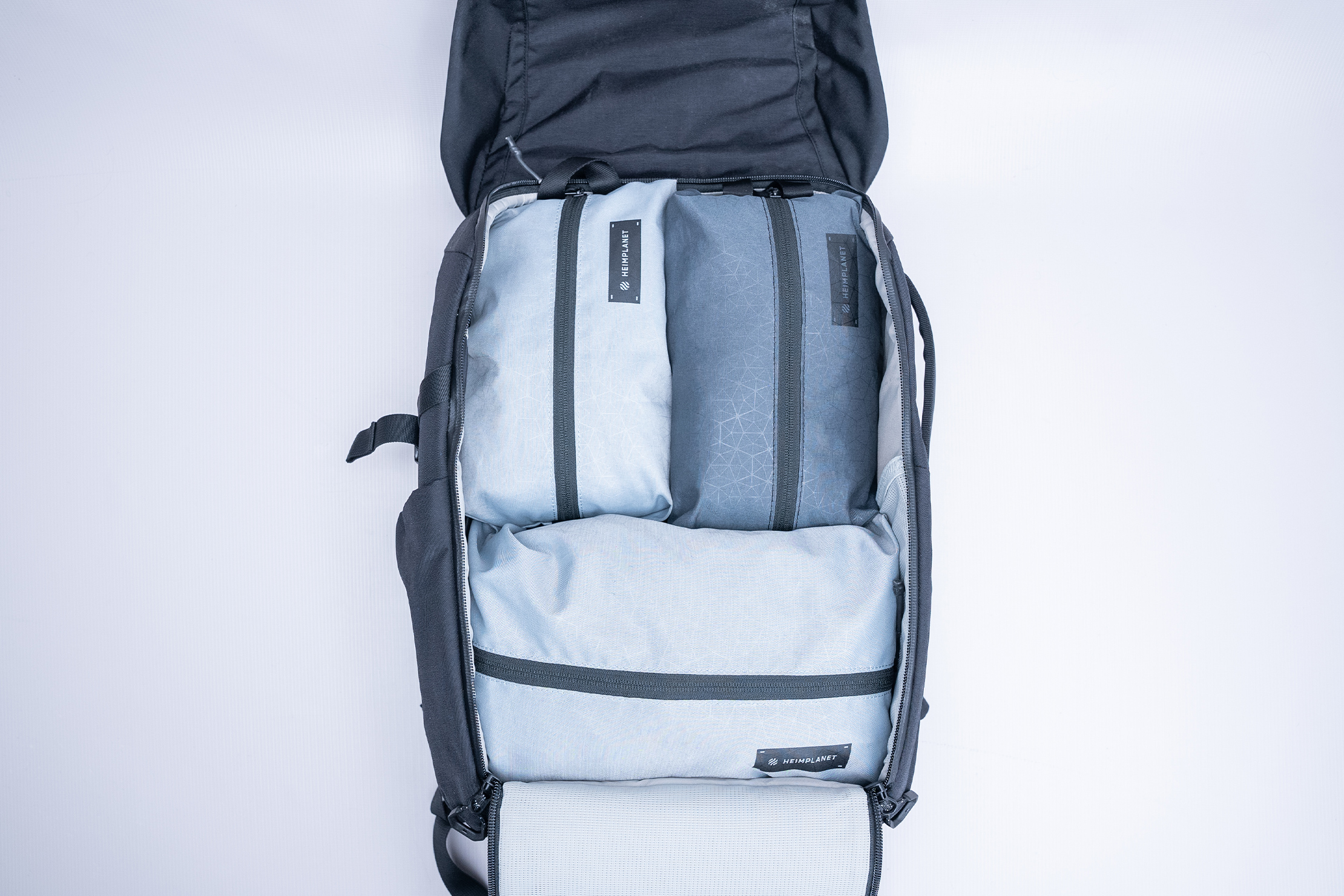
As for space, the interior is roomy enough to pack a weekend’s worth of clothing with some room to spare. It’s not in the same league as travel-focused backpacks. However, the packing experience reminds us of those types of bags because of their excellent structure and clamshell opening.
Usage Timeline
Condition: Excellent
- Super structured, which makes sense since it’s designed to protect your tech
- Interested to see if the laptop compartment drop protection feels more secure than a classic false bottom
- Inside seems spacious and features decent organization
Condition: Excellent
- Materials still in great shape
- Unsure if the extra tech protection does much
- Some internal organization is blocked by gear you load on top, which makes it hard to get to on the go
- Wide opening makes it super easy to pack

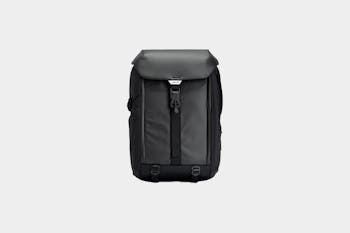






Get your questions about the Mous Extreme Commuter Backpack with Lid answered from our team and the Pro Community right here on the page. Plus, join discussions with other members about gear, guides, and more.
Join Pack Hacker Pro or, Sign In